Back-Tested Results: Antifragile Strategy vs. Traditional Holding
Explore the science-based approach behind our Antifragile Portfolio Strategy, supported by rigorous testing and consistent historical performance.
Testing setup:
We conducted simulations of 44,671 portfolios to compare the performance of the Antifragile strategy against traditional holding. These simulations utilized five distinct datasets, each containing price data for 15 to 19 cryptocurrencies, including Bitcoin (BTC) and Ethereum (ETH). From each dataset, three types of portfolios (each containing six coins) were simulated:
Type 1: Portfolios including BTC and ETH, each with a 30% allocation, alongside four other coins with a 10% allocation each.
Type 2: Portfolios including BTC, ETH, and four other coins, all equally allocated at 16.666%.
Type 3: Portfolios excluding BTC and ETH, consisting of six altcoins with equal allocations of 16.666% each.
Statistical Analyses:
To validate our findings, we also conducted rigorous statistical analyses on all portfolios results. Analyses including:
Paired t-test
Wilcoxon signed-rank test
Both tests indicated a statistically significant difference between the antifragile strategy and the holding strategy, with p-values approaching zero. These findings suggest that, in these back-tested scenarios, the antifragile strategy demonstrated consistent performance advantages over traditional holding.
The antifragile strategy’s performance consistency across different allocations, time periods, and a broad set of cryptocurrencies suggests it may offer a versatile approach to portfolio management. However, please note that past performance in simulations does not guarantee future results, and all investments carry risk.
Dataset 1 Analysis: This dataset features price data from 15 cryptocurrencies spanning January 1, 2020, to December 31, 2024. We conducted simulations on 3146 portfolios containing six coins, both with and without BTC and ETH. Below are the top-performing portfolios that delivered the highest gains.
Type 1: Portfolio Includes BTC and ETH, each with a 30% allocation and 4 Other Coins with 10% each
Statistical analyses: (1) t-statistic = 39.63, p-value = 1.74e-182; (2) W-statistic = 0.0, p-value = 1.02e-118.
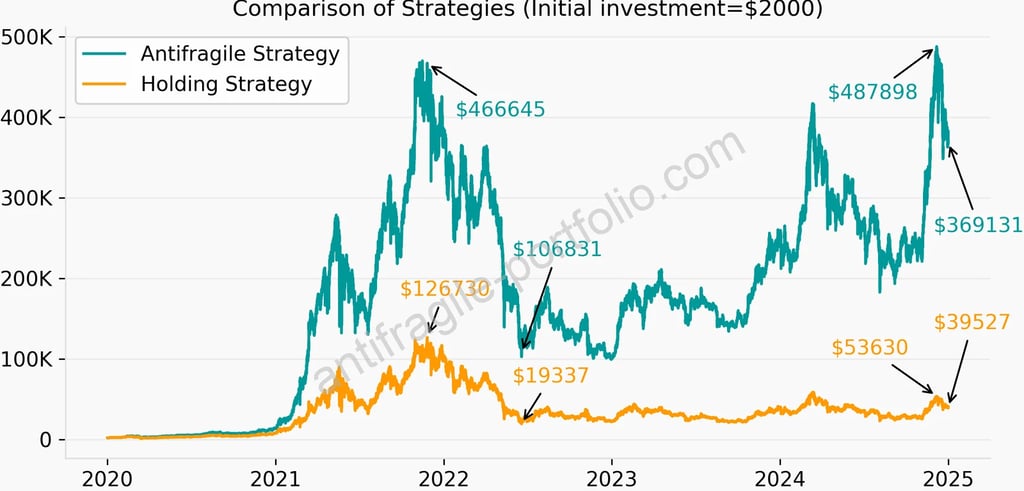

Type 2: Portfolio Includes BTC, ETH and 4 Other Coins with Equal Allocation (16.666% each)
Statistical analyses: (1) t-statistic = 24.78, p-value = 2.49e-98; (2) W-statistic = 0.0, p-value = 1.02e-118
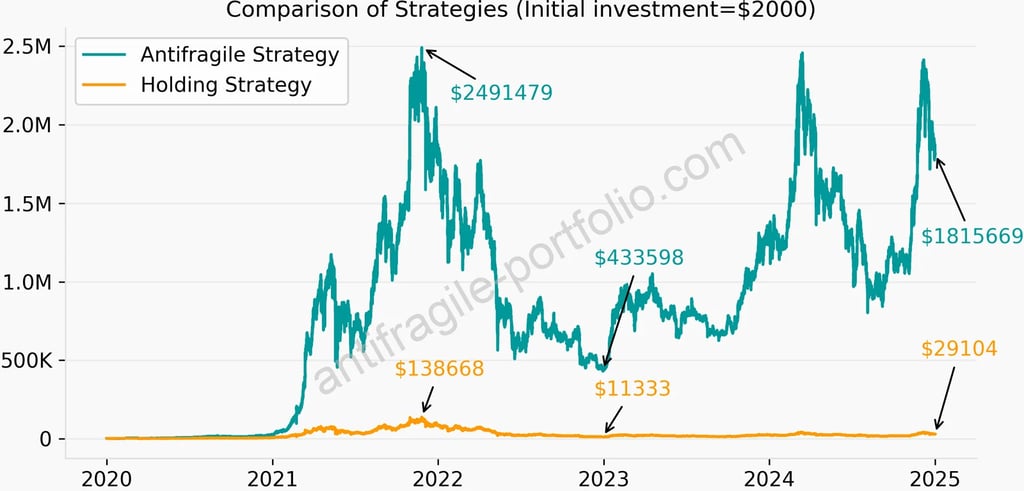

Type 3: Portfolios excluding BTC and ETH, consisting of six altcoins with equal allocations of 16.666% each
Statistical analyses: (1) t-statistic = 42.71, p-value = 3.61e-272; (2) W-statistic = 0.0, p-value = 6.26e-282
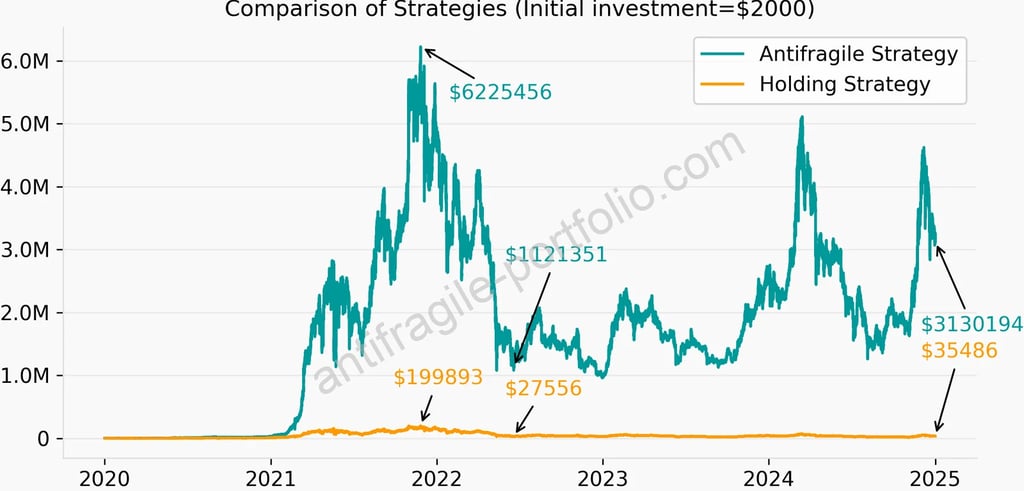

Dataset 2 Analysis: This dataset features price data from 16 cryptocurrencies spanning April 10, 2020, to December 31, 2024. We conducted simulations on 5005 portfolios, both with and without BTC and ETH. Below are the top-performing portfolios that delivered the highest gains.
Type 1: Portfolio Includes BTC and ETH, each with a 30% allocation and 4 Other Coins with 10% each
Statistical analyses: (1) t-statistic = 54.64, p-value = 1.56e-302; (2) W-statistic = 0.0, p-value = 2.28e-165.
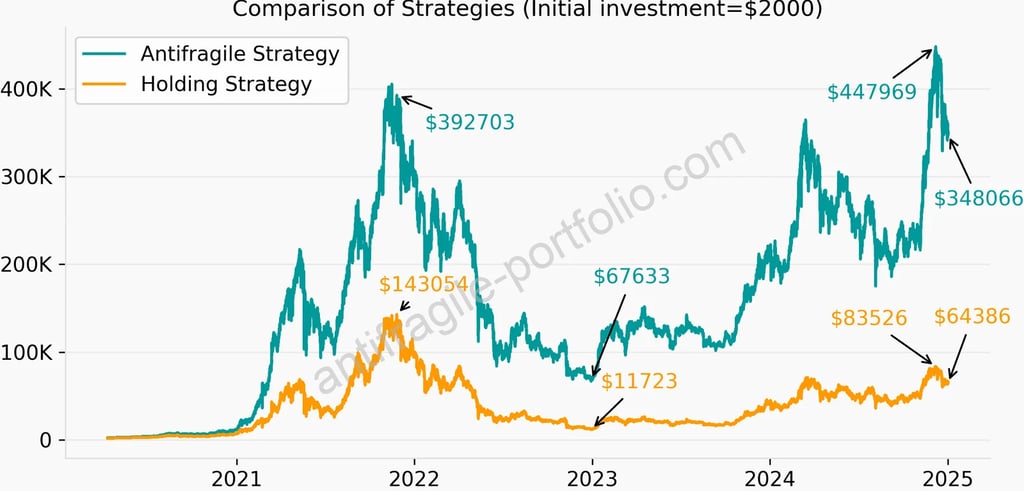

Type 2: Portfolio Includes BTC, ETH and 4 Other Coins with Equal Allocation (16.666% each)
Statistical analyses: (1) t-statistic = 33.12, p-value = 4.99e-163; (2) W-statistic = 0.0, p-value = 2.28e-165
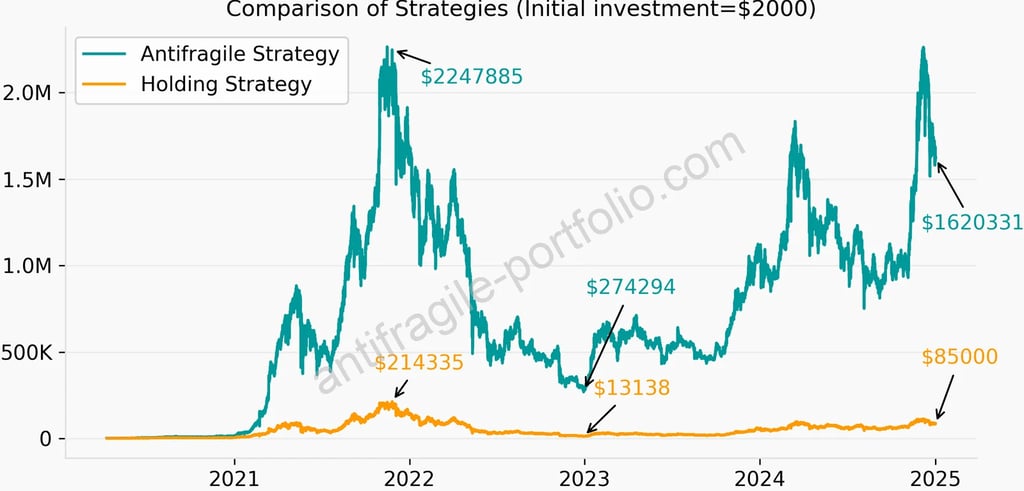

Type 3: Portfolios excluding BTC and ETH, consisting of six altcoins with equal allocations of 16.666% each
Statistical analyses: (1) t-statistic = 58.10, p-value = 0.0; (2) W-statistic = 0.0, p-value = 0.0
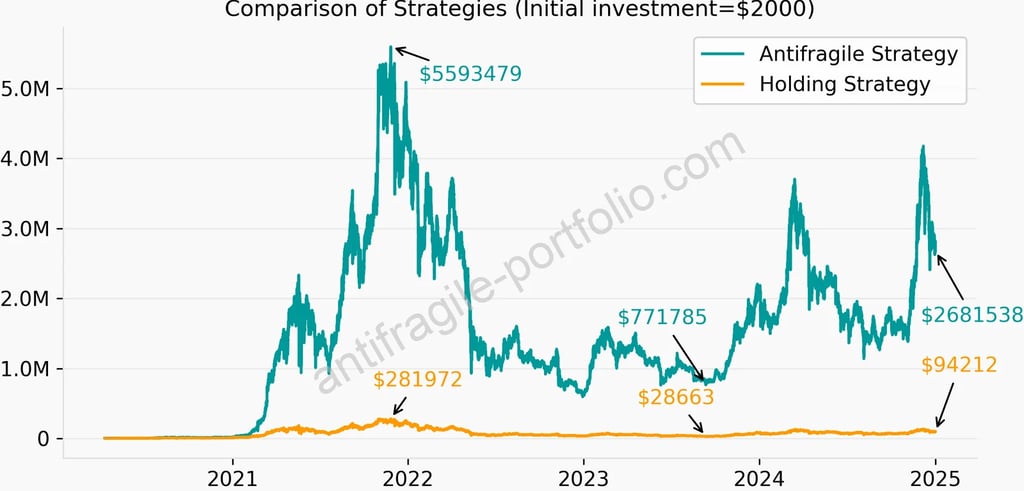

Dataset 3 Analysis: This dataset features price data from 17 cryptocurrencies spanning August 14, 2020, to December 31, 2024. We conducted simulations on 7735 portfolios, both with and without BTC and ETH. Below are the top-performing portfolios that delivered the highest gains.
Type 1: Portfolio Includes BTC and ETH, each with a 30% allocation and 4 Other Coins with 10% each
Statistical analyses: (1) t-statistic = 48.84, p-value = 7.91e-302; (2) W-statistic = 0.0, p-value = 1.02e-224.
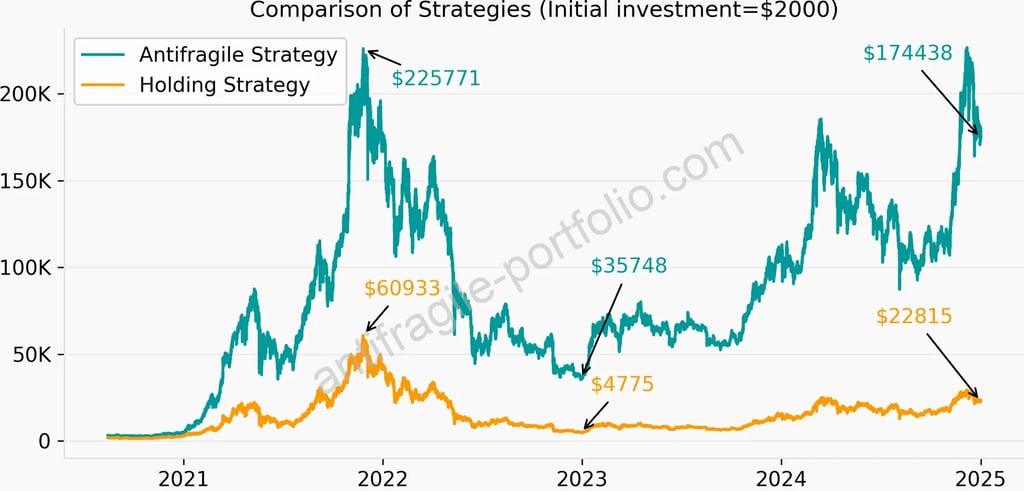

Type 2: Portfolio Includes BTC, ETH and 4 Other Coins with Equal Allocation (16.666% each)
Statistical analyses: (1) t-statistic = 35.52, p-value = 2.90e-196; (2) W-statistic = 7.0, p-value = 1.04e-224
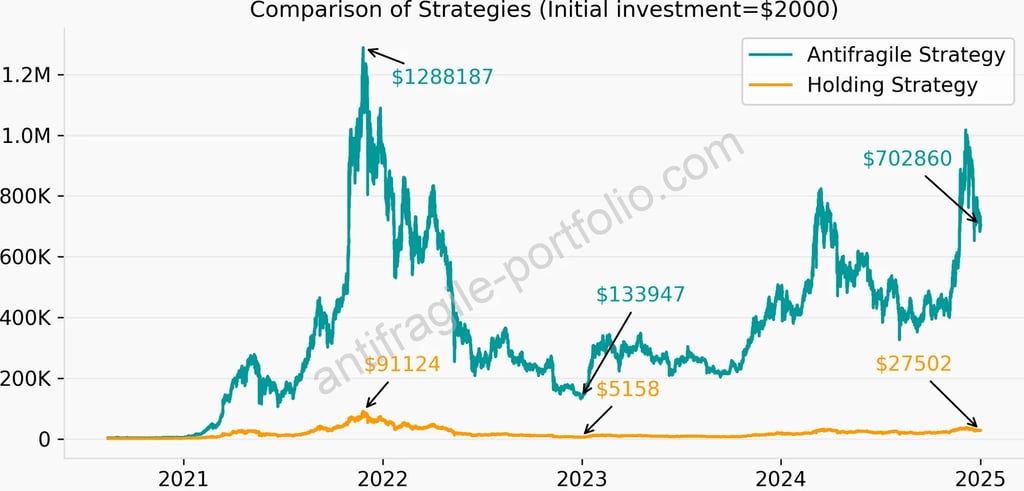

Type 3: Portfolios excluding BTC and ETH, consisting of six altcoins with equal allocations of 16.666% each
Statistical analyses: (1) t-statistic = 70.80, p-value = 0.0; (2) W-statistic = 37.0, p-value = 0.0
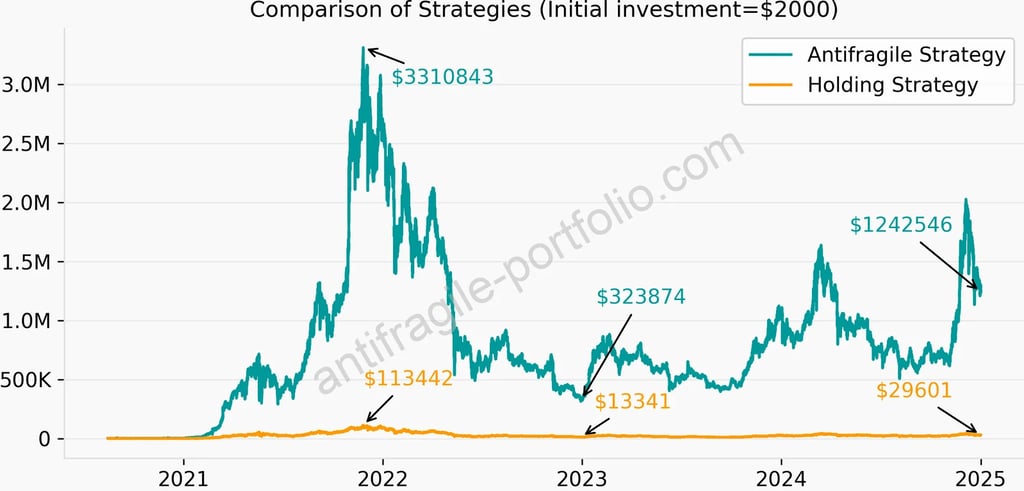

Dataset 4 Analysis: This dataset features price data from 18 cryptocurrencies spanning August 20, 2020, to December 31, 2024. We conducted simulations on 11,648 portfolios, both with and without BTC and ETH. Below are the top-performing portfolios that delivered the highest gains.
Type 1: Portfolio Includes BTC and ETH, each with a 30% allocation and 4 Other Coins with 10% each
Statistical analyses: (1) t-statistic = 75.59, p-value = 0.0; (2) W-statistic = 0.0, p-value = 7.02e-299
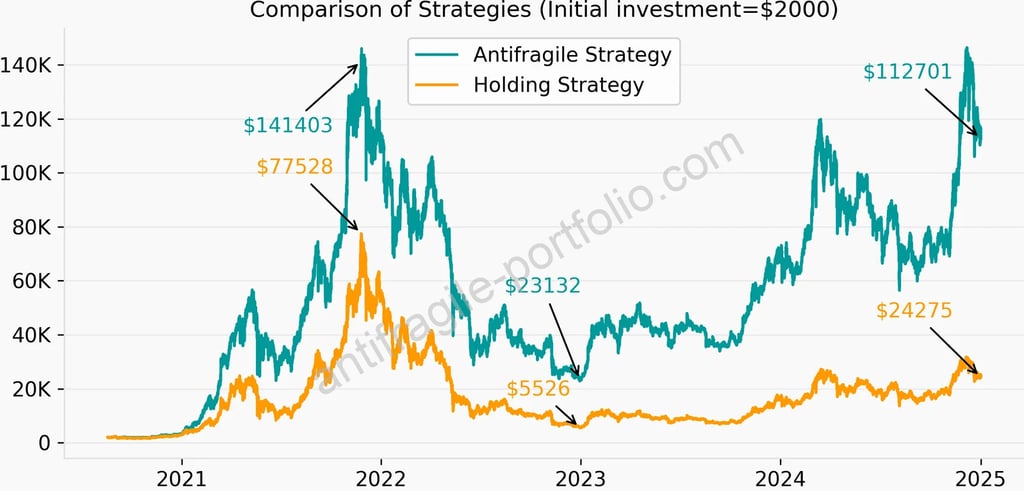

Type 2: Portfolio Includes BTC, ETH and 4 Other Coins with Equal Allocation (16.666% each)
Statistical analyses: (1) t-statistic = 51.26, p-value = 0.0; (2) W-statistic = 35.0, p-value = 7.44e-299
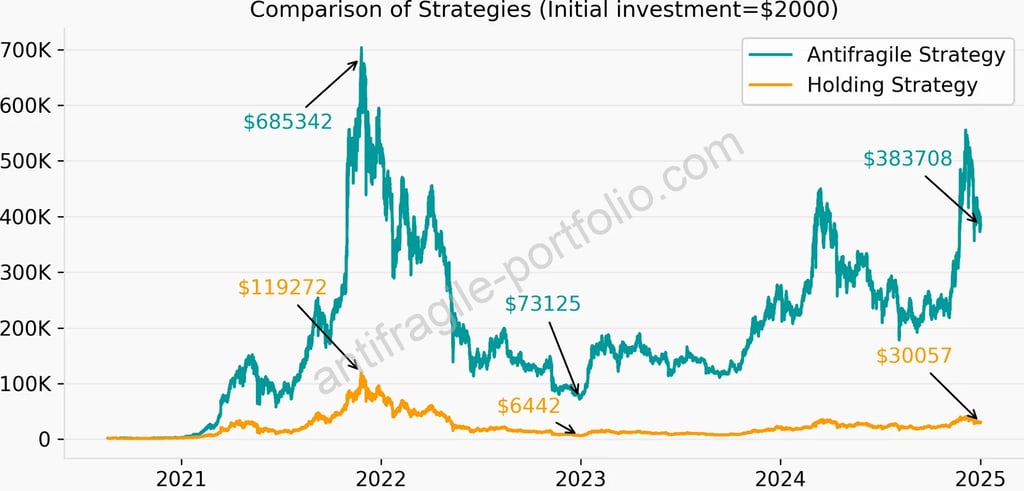

Type 3: Portfolios excluding BTC and ETH, consisting of six altcoins with equal allocations of 16.666% each
Statistical analyses: (1) t-statistic = 105.95, p-value = 0.0; (2) W-statistic = 573.0, p-value = 0.0
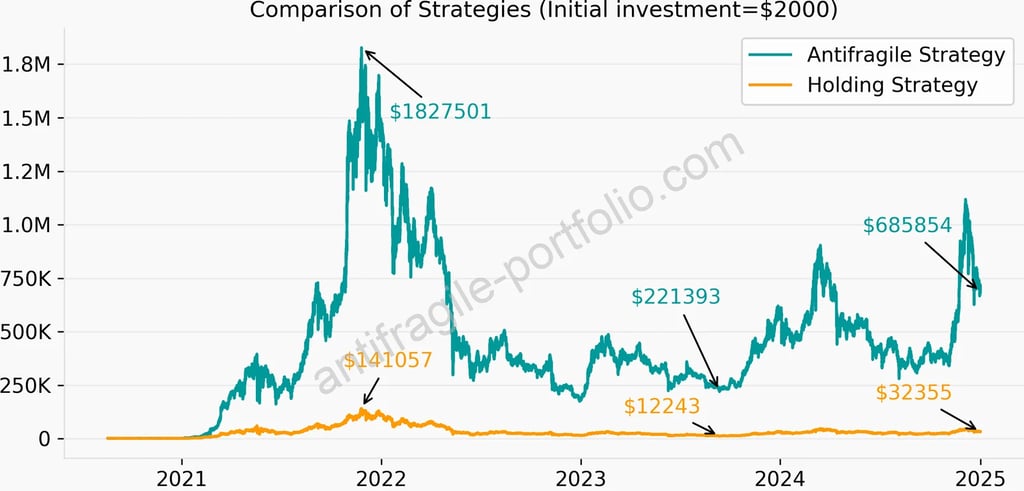

Dataset 5 Analysis: This dataset features price data from 19 cryptocurrencies spanning December 15, 2020, to December 31, 2024. We conducted simulations on 17,137 portfolios, both with and without BTC and ETH. Below are the top-performing portfolios that delivered the highest gains.
Type 1: Portfolio Includes BTC and ETH, each with a 30% allocation and 4 Other Coins with 10% each
Statistical analyses: (1) 55.84, p-value = 0.0; (2) W-statistic = 146086.0, p-value = 0.0
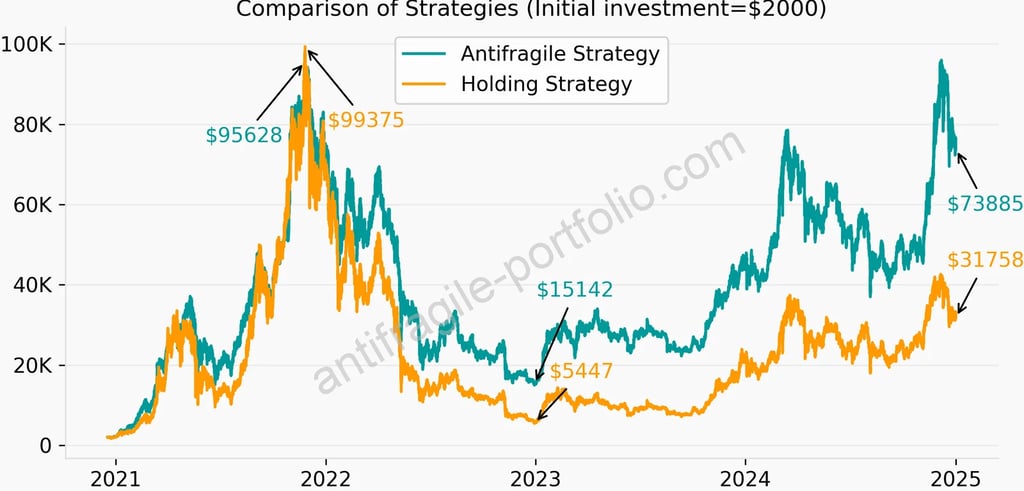

Type 2: Portfolio Includes BTC, ETH and 4 Other Coins with Equal Allocation (16.666% each)
Statistical analyses: (1) t-statistic = 48.78, p-value = 0.0; (2) W-statistic = 89190.0, p-value = 0.0
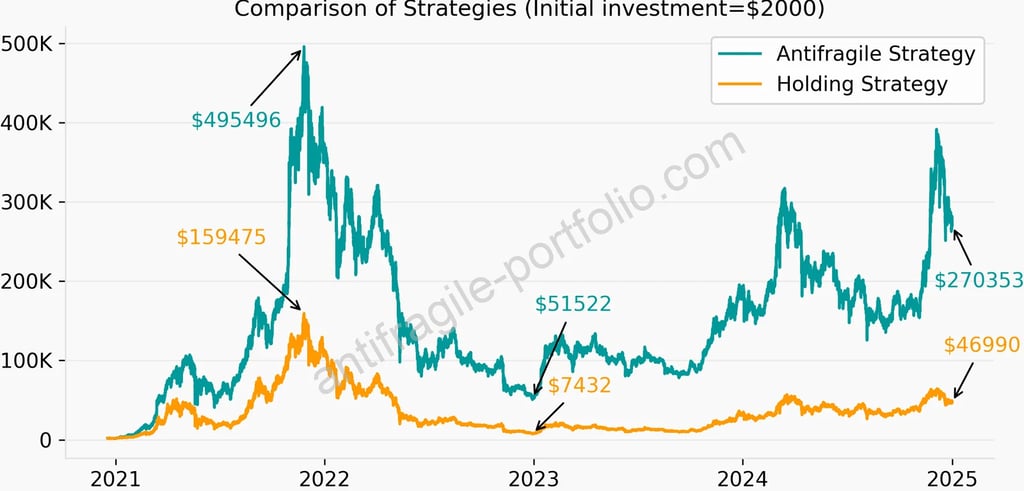

Type 3: Portfolios excluding BTC and ETH, consisting of six altcoins with equal allocations of 16.666% each
Statistical analyses: (1) t-statistic = 110.16, p-value = 0.0; (2) W-statistic = 1139796.0, p-value = 0.0
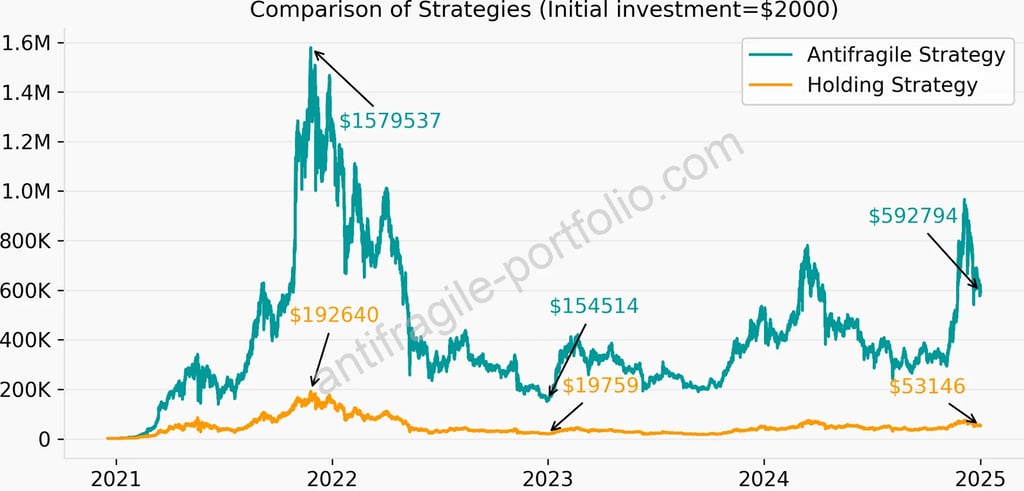

Box Plots: Highlighting the Antifragile Advantage Over Traditional Holding
Box plots showcase the top 25 portfolios from each dataset, revealing the extraordinary performance of the antifragile strategy. These visualizations demonstrate the remarkable growth and resilience delivered by our innovative approach, consistently outperforming traditional holding methods.
To validate our findings, we conducted rigorous statistical analyses on all portfolios, including:
Paired t-test
Wilcoxon signed-rank test
Both tests confirm a highly significant difference between the antifragile and holding strategies, with p-values approaching zero. This provides robust statistical evidence of the antifragile strategy’s superior performance.
The box plots depict the portfolio values as of 31.12.2024.
Dataset 1 Analysis: Top 25 Portfolios with Allocations - 30% each in BTC and ETH, and 10% each in 4 additional coins.
Statistical analyses: (1) t-statistic = 39.63, p-value = 1.74e-182; (2) W-statistic = 0.0, p-value = 1.02e-118
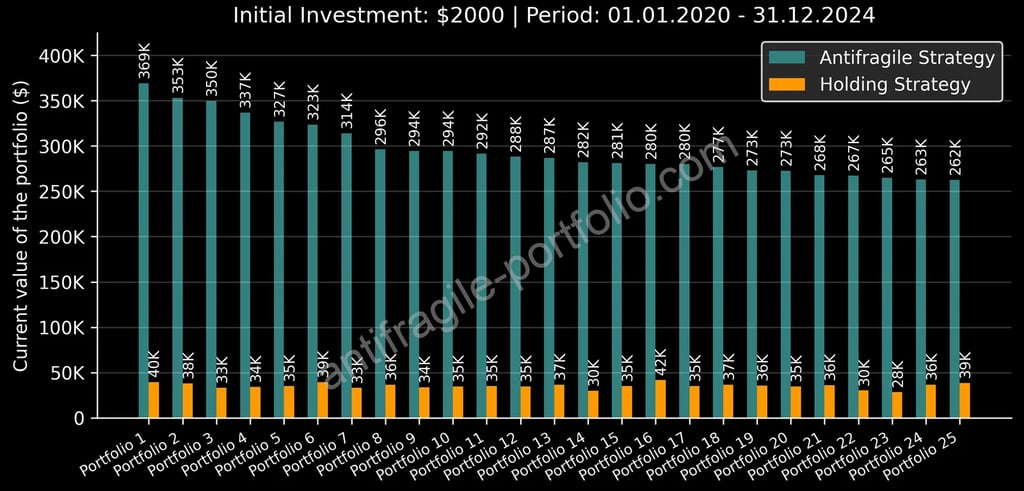

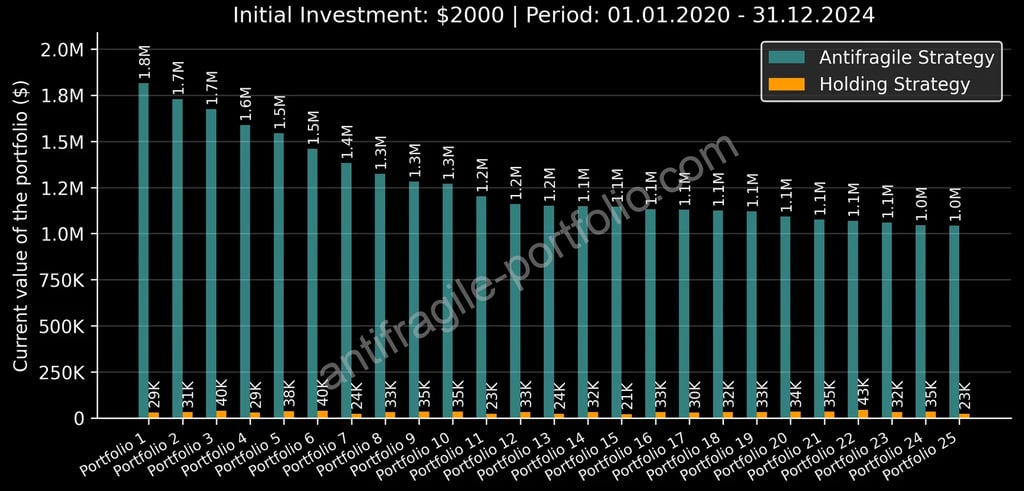

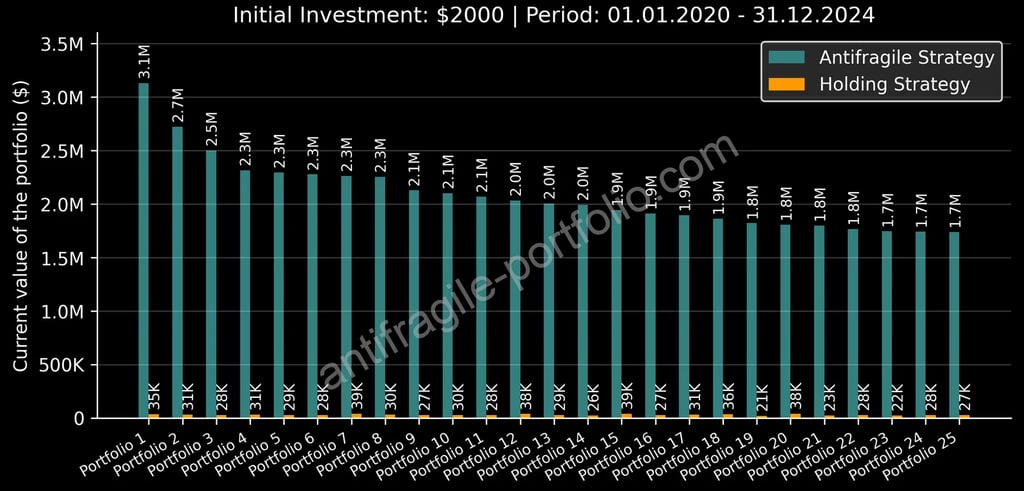

Dataset 1 Analysis: Top 25 Portfolios with - Equal Allocations 16.666% each in BTC, ETH, and 4 additional coins.
Statistical analyses: (1) t-statistic = 24.78, p-value = 2.49e-98; (2) W-statistic = 0.0, p-value = 1.02e-118
Dataset 1 Analysis: Top 25 Portfolios Excluding BTC and ETH - Allocations of 16.666% in 6 Coins Each.
Statistical analyses: (1) t-statistic = 42.71, p-value = 3.61e-272; (2) W-statistic = 0.0, p-value = 6.26e-282
Dataset 2 Analysis: Top 25 Portfolios with Allocations of BTC and ETH (30% each) plus 4 Other Coins (10% each)
Statistical analyses: (1) t-statistic = 54.64, p-value = 1.56e-302; (2) W-statistic = 0.0, p-value = 2.28e-165
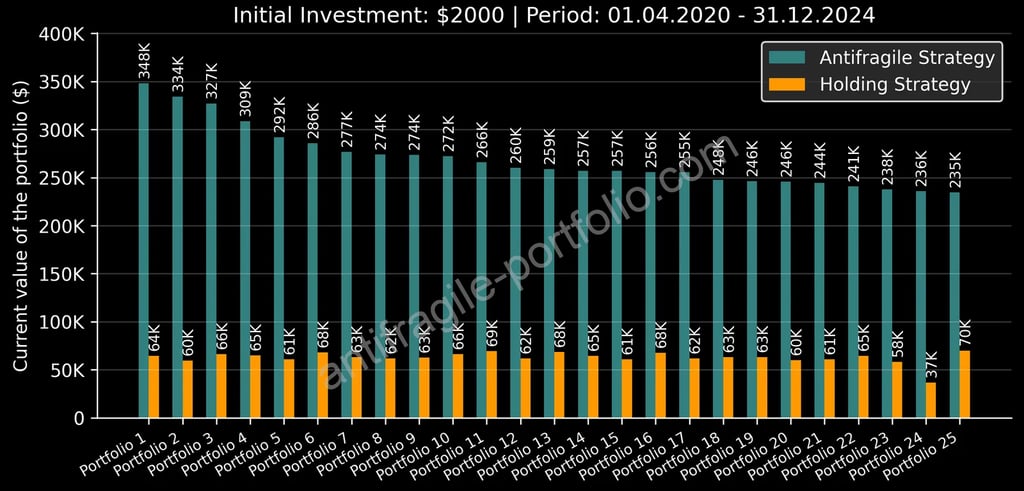



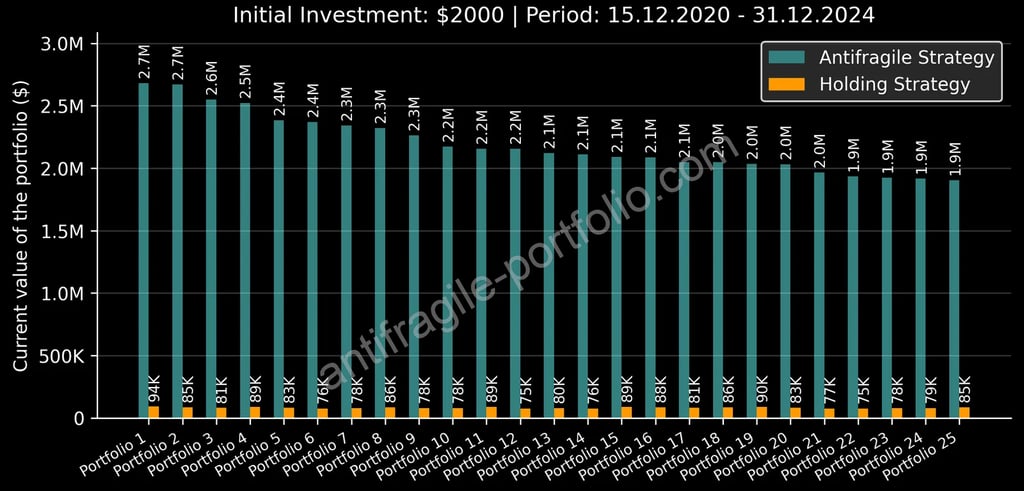

Dataset 2 Analysis: Top 25 Portfolios with - Equal Allocations 16.666% each in BTC, ETH, and 4 additional coins.
Statistical analyses: (1) t-statistic = 33.12, p-value = 4.99e-163; (2) W-statistic = 0.0, p-value = 2.28e-165
Dataset 2 Analysis: Top 25 Portfolios Exclude BTC and ETH: 6 Coins with 16.666% Allocation Each
Statistical analyses: (1) t-statistic = 58.10, p-value = 0.0; (2) W-statistic = 0.0, p-value = 0.0
Dataset 3 Analysis: Top 25 Portfolios with Allocations of BTC and ETH (30% each) plus 4 Other Coins (10% each)
Statistical analyses: (1) t-statistic = 48.84, p-value = 7.91e-302; (2) W-statistic = 0.0, p-value = 1.02e-224
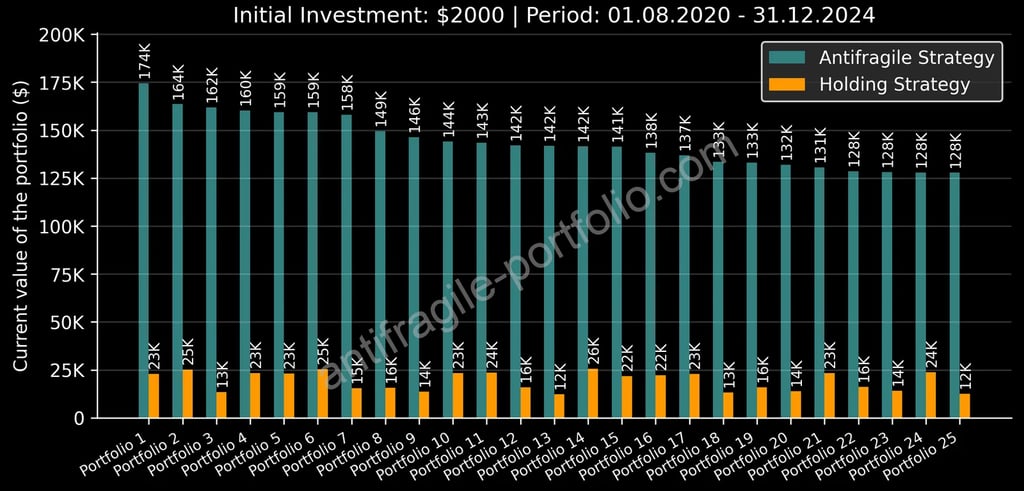



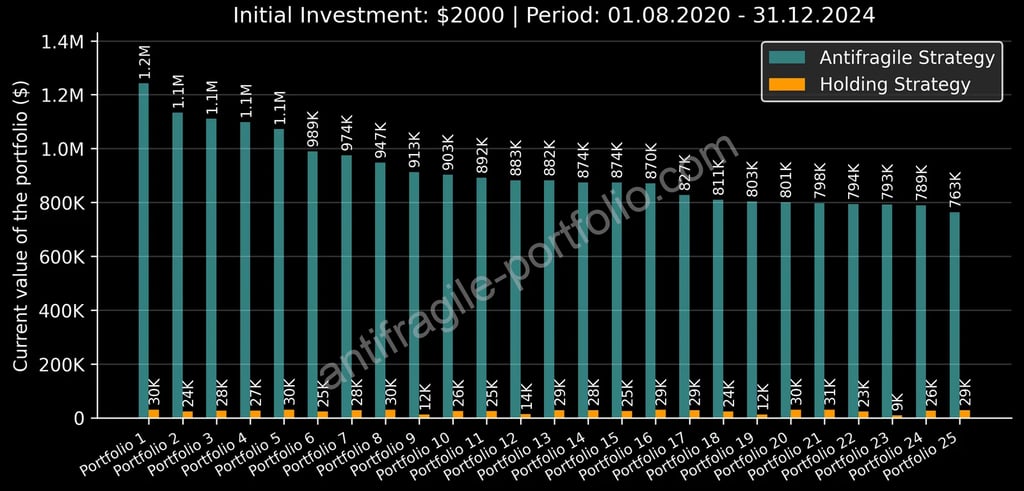

Dataset 3 Analysis: Top 25 Portfolios with - Equal Allocations 16.666% each in BTC, ETH, and 4 additional coins.
Statistical analyses: (1) t-statistic = 35.52, p-value = 2.90e-196; (2) W-statistic = 7.0, p-value = 1.04e-224
Dataset 3 Analysis: Top 25 Portfolios Exclude BTC and ETH: 6 Coins with 16.666% Allocation Each
Statistical analyses: (1) t-statistic = 70.80, p-value = 0.0; (2) W-statistic = 37.0, p-value = 0.0
Dataset 4 Analysis: Top 25 Portfolios with Allocations of BTC and ETH (30% each) plus 4 Other Coins (10% each)
Statistical analyses: (1) t-statistic = 75.59, p-value = 0.0; (2) W-statistic = 0.0, p-value = 7.02e-299
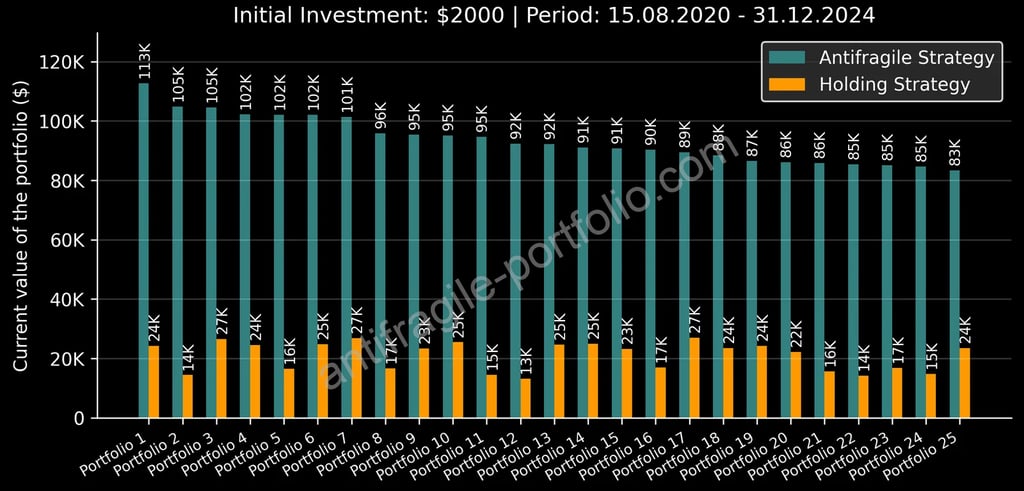

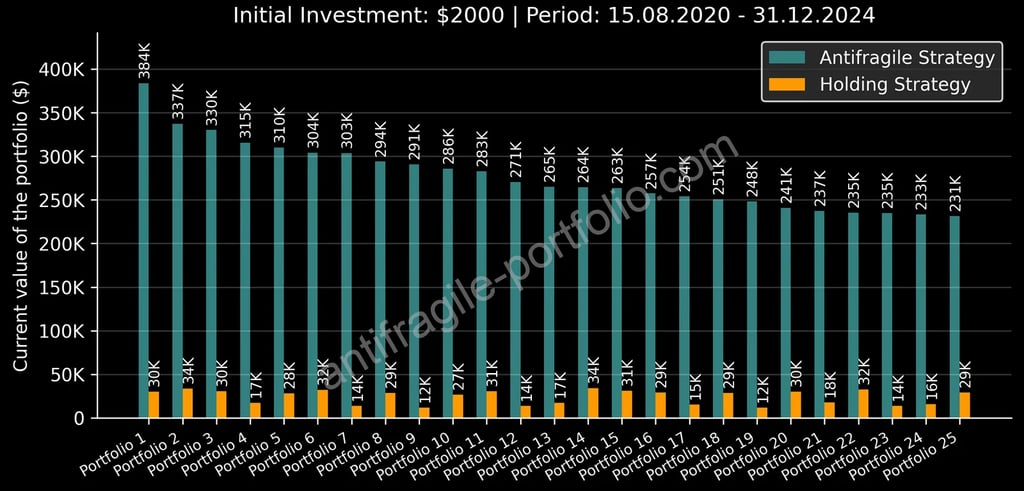

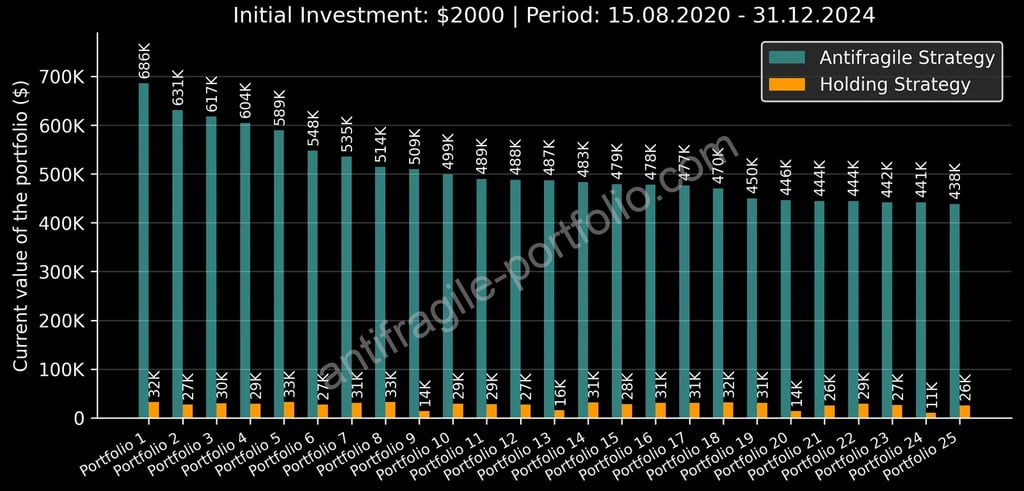

Dataset 4 Analysis: Top 25 Portfolios with - Equal Allocations 16.666% each in BTC, ETH, and 4 additional coins.
Statistical analyses: (1) t-statistic = 51.26, p-value = 0.0; (2) W-statistic = 35.0, p-value = 7.44e-299
Dataset 4 Analysis: Top 25 Portfolios Exclude BTC and ETH: 6 Coins with 16.666% Allocation Each
Statistical analyses: (1) t-statistic = 105.95, p-value = 0.0; (2) W-statistic = 573.0, p-value = 0.0
Dataset 5 Analysis: Top 25 Portfolios with Allocations of BTC and ETH (30% each) plus 4 Other Coins (10% each)
Statistical analyses: (1) 55.84, p-value = 0.0; (2) W-statistic = 146086.0, p-value = 0.0






Dataset 5 Analysis: Top 25 Portfolios with - Equal Allocations 16.666% each in BTC, ETH, and 4 additional coins.
Statistical analyses: (1) t-statistic = 48.78, p-value = 0.0; (2) W-statistic = 89190.0, p-value = 0.0
Dataset 5 Analysis: Top 25 Portfolios Exclude BTC and ETH: 6 Coins with 16.666% Allocation Each
Statistical analyses: (1) t-statistic = 110.16, p-value = 0.0; (2) W-statistic = 1139796.0, p-value = 0.0
